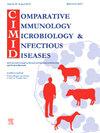Molecular detection and phylogenetic characterization of Borrelia theileri and a putative novel Borrelia genotype in Hyalomma dromedarii ticks infesting camels in southern Egypt
IF 2
3区 农林科学
Q4 IMMUNOLOGY
Comparative Immunology Microbiology and Infectious Diseases
Pub Date : 2025-09-05
DOI:10.1016/j.cimid.2025.102403
引用次数: 0
Abstract
Ticks are important vectors of various pathogens affecting human and animal health globally. In Egypt, camels are frequently infested with Hyalomma dromedarii, yet their role in harboring and transmitting tick-borne pathogens remains poorly understood. This study aimed to molecularly detect and characterize Borrelia species in H. dromedarii ticks collected from camels in three cities in southern Egypt: Esna, Draw, and Edfu. Of 300 ticks analyzed using PCR targeting the 16S rRNA and flaB genes, 21.3 % (64/300) tested positive for Borrelia species. The highest prevalence was recorded in Edfu (37 %), followed by Draw (19 %) and Esna (13.3 %). Sequencing of the flaB gene revealed two distinct genetic groups. Phylogenetic analysis demonstrated that one group clustered closely with Borrelia theileri, while the second formed a distinct clade within the relapsing fever group of Borrelia species, showing sufficient genetic divergence to suggest a putative novel genotype or locally adapted strain. This clade was supported by high bootstrap values (99 %) and showed no close relation to previously described species. To our knowledge, this study represents the first detection of B. theileri in camel-associated ticks in Egypt. These findings expand the known genetic diversity of Borrelia species in North Africa and highlight the need for further studies to assess the pathogenic potential and epidemiological significance of these strains in animal and human populations.
埃及南部骆驼透明眼蜱中疏螺旋体的分子检测和系统发育特征及推测的新型疏螺旋体基因型
蜱是影响全球人类和动物健康的各种病原体的重要媒介。在埃及,骆驼经常感染单峰透明瘤,但它们在窝藏和传播蜱传病原体方面的作用仍然知之甚少。本研究旨在对埃及南部埃斯纳、德鲁和埃德夫三个城市骆驼采集的单峰骆驼蜱中的疏螺旋体进行分子检测和特征鉴定。对300只蜱进行16S rRNA和flaB基因的PCR检测,结果显示伯氏疏螺旋体阳性率为21.3% %(64/300)。Edfu的患病率最高(37% %),其次是Draw(19% %)和Esna(13.3% %)。flaB基因的测序揭示了两个不同的遗传群。系统发育分析表明,其中一组与疏螺旋体紧密聚集在一起,而另一组在疏螺旋体物种的回归热组中形成了一个独特的分支,显示出足够的遗传差异,表明可能存在新的基因型或局部适应菌株。该支系具有较高的自举值(99 %),与先前描述的物种没有密切关系。据我们所知,这项研究代表了埃及首次在骆驼相关蜱中检测到他们的杆菌。这些发现扩大了北非已知伯氏疏螺旋体物种的遗传多样性,并强调需要进一步研究以评估这些菌株在动物和人类群体中的致病潜力和流行病学意义。
本文章由计算机程序翻译,如有差异,请以英文原文为准。
求助全文
约1分钟内获得全文
求助全文
来源期刊
CiteScore
4.60
自引率
0.00%
发文量
102
审稿时长
40 days
期刊介绍:
Comparative Immunology, Microbiology & Infectious Diseases aims to respond to the concept of "One Medicine" and to provide a venue for scientific exchange. Based on the concept of "Comparative Medicine" interdisciplinary cooperation between specialists in human and animal medicine is of mutual interest and benefit. Therefore, there is need to combine the respective interest of physicians, veterinarians and other health professionals for comparative studies relevant to either human or animal medicine .
The journal is open to subjects of common interest related to the immunology, immunopathology, microbiology, parasitology and epidemiology of human and animal infectious diseases, especially zoonotic infections, and animal models of human infectious diseases. The role of environmental factors in disease emergence is emphasized. CIMID is mainly focusing on applied veterinary and human medicine rather than on fundamental experimental research.

 求助内容:
求助内容: 应助结果提醒方式:
应助结果提醒方式:


